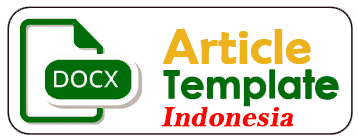The Urgency Of Learning Quranic Sign Language Using HATI Method For Students Of Islamic Education Department UIN SMH Banten
DOI:
https://doi.org/10.47200/ulumuddin.v14i1.2506Keywords:
Quran sign language, Islamic education, disabilityAbstract
The development of inclusive learning methods is growing the needs of students in accordance with the directives of the Minister of National Education Number 70/2009 concerning Inclusive Education. The method of learning the Alquran in sign language is also of particular concern. This is reinforced by one of God's words in Qs. Al-Qamar/54 which is repeated four times in verses 17, 22, 32 and 40 regarding the guarantee that Allah makes it easy for the Alquran to be read, studied and memorized including those with the deaf. The importance of learning the Alquran in sign language, students of PAI department need to be equipped with competence regarding the sign language Alquran so that they have special abilities to teach the Alquran both in spoken and sign language. The learning method of the Alquran in sign language is certainly different from oral learning. However, even though the deaf do not use their voice when reading and memorizing the Qur'an, the deaf can still understand and interpret it (Azwar Hairul, 2022). In addition, learning the Alquran in sign language must at least go through three stages are therapy (oral and vocal), reading practice and practice (Ma'ruf P Subekti, 2020). Therefore, in order to create uniformity in learning the signed Alquran, Lajnah Pentashihan Mushaf Alquran (LPMQ) of the Ministry of Religion of the Republic of Indonesia and all deaf institutions and communities agreed on a form of the Alquran in sign language which can now be viewed live through the Indonesian Ministry of Religion's digital Alquran website https://quran.kemenag.go.id/. This paper will explain the importance of learning the Qur'an with signs with HATI methods can be applied to students as messengers of the Qur'an in the future in educational institutions and in society.
Downloads
References
Admin. “Daftar Pendidikan Khusus (SLB) Di Kota Serang Beserta Alamatnya.” DataPendidikan.com, n.d. https://datapendidikan.com:443/pendidikan-husus/kota/serang/.
Badan Pusat Statistik Provinsi DKI Jakarta, “Disabilitas dalam Angka” https://jakarta.bps.go.id/news/2023/01/05/828/disabilitas-dalam-angka.html diunduh pada Sabtu, 15 Juli 2023, 16.23 Wib.
Bayu Pamungkas and Hermanto Hermanto, “Tahapan Belajar Al Qur’an Menggunakan Huruf Hijaiyah Isyarat Bagi Anak Dengan Hambatan Pendengaran,” Jurnal Pendidikan Kebutuhan Khusus 6, no. 1 (2022): 34–41, https://doi.org/10.24036/jpkk.v6i1.621.
Dadang Iskandar Mulyana, Muhammad Faizal Lazuardi, and Mesra Betty Yel, “Deteksi Bahasa Isyarat Dalam Pengenalan Huruf Hijaiyah Dengan Metode YOLOV5,” Jurnal Teknik Elektro Dan Komputasi (ELKOM) 4, no. 2 (2022): 145–1.
Hairul, Moh. Azwar. “Resepsi Al-Qur’an Dalam Budaya Tuli : Studi Komunitas Gerkatin Gorontalo.” Jurnal Ilmiah AL-Jauhari: Jurnal Studi Islam Dan Interdisipliner 7, no. 2 (2022): 161–76. https://doi.org/10.30603/jiaj.v7i2.2991.
Huda, Nurul. “Aplikasi Bahasa Isyarat Pengenalan Huruf Hijaiyah.” Sisfokom 8, no. 1 (2019): 1–6. https://doi.org/10.32736/ sisfokom.v8i1.582.
Imroatun, Imroatun, Birru Muqdamien, Ilzamudin Ilzamudin, and Muhajir Muhajir. “Pengenalan Huruf Hijaiyah untuk Anak Usia Dini melalui Pengasuhan Informal di Indonesia.” Jurnal Obsesi : Jurnal Pendidikan Anak Usia Dini 7, no. 3 (June 30, 2023): 3639–47. https://doi.org/10.31004/obsesi.v7i3.4534.
Iskandar Mulyana, Dadang, Muhammad Faizal Lazuardi, and Mesra Betty Yel. “Deteksi Bahasa Isyarat Dalam Pengenalan Huruf Hijaiyah Dengan Metode YOLOV5.” Jurnal Teknik Elektro Dan Komputasi (ELKOM) 4, no. 2 (2022): 145–1.
Islami, Azmi, Imroatun Imroatun, Nurlaeli Nurlaeli, Dind Ibra Benign Sajid, Parid Samael, and Zainul Arifin. “Manajemen Pembelajaran Ilmu Tajwid Melalui Nadhom Di Pesantren.” Asas Wa Tandhim: Jurnal Hukum, Pendidikan Dan Sosial Keagamaan 3, no. 1 (2024): 21–30. https://doi.org/10.47200/awtjhpsa.v3i1.2051.
Jamil, Ahmad, Naswan Abdo Khaled, and Harun al Rasyid. “The Accessibility of Tahfidz Al-Qur’an for Teachers with Disabilities at the Tahfidz Daarul Qur’an Islamic Boarding School.” Tarbiya: Journal of Education in Muslim Society 9, no. 2 (n.d.): 2022.
Kementerian Kesehatan RI, ‘60% Gangguan Pendengaran Dapat Dicegah’ https://www.kemkes.go.id/article/view/23030400002/60-gangguan-pendengaran-dapat-dicegah.html Dipublikasi pada 1 Maret 2023, diunduh pada Sabtu, 15 Juli 2023, 16.19 Wib.
Mud, Salmihah Che, Fariza Md Sham, and Manisah Mohd Ali. “Learning Al-Quran For Children With Disabilities (Pembelajaran al-Quran Untuk Anak Kelainan Upaya).” Jurnal Hadhari: An International Journal 13, no. 1 (June 30, 2021): 135–46.
Nugroho, Taufik, Muhammad Nasrudin, Fadilah Fadilah, Ahmad Reihan Syavicky, and Yurniati Yurniati. “Pendampingan Pengembangan Materi Ajar PAI Moderasi Beragama Di TPA Taman Bocah Permata Hati Sleman.” Nuansa Akademik: Jurnal Pembangunan Masyarakat 9, no. 1 (2024).
Oktavia, Anisa Eka, Evie Syalviana, Fardan Abdillah, and Syahrul Syahrul. “Metode Bahasa Isyarat Dalam Baca Tulis Al-Qur’an Untuk Anak Tunarungu di Kawasan Minoritas Muslim Papua.” Jurnal Ilmiah Wahana Pendidikan 9, no. 3 (February 4, 2023): 85–96. https://doi.org/10.5281/zenodo.7605306.
Oktaviani, Zahrotul. “Studi: Perlu Pedoman Baca Alquran Tunarungu dan Tunawicara.” Republika Online, November 21, 2021. https://republika.co.id/share/r2xe5l320.
Pamungkas, Bayu, and Hermanto Hermanto. “Tahapan Belajar Al Qur’an Menggunakan Huruf Hijaiyah Isyarat Bagi Anak Dengan Hambatan Pendengaran.” Jurnal Pendidikan Kebutuhan Khusus 6, no. 1 (2022): 34–41. https://doi.org/10.24036/jpkk.v6i1.621.
Pedoman Alquran Berbahasa Isyarat, Lembaga Pentashih Mushaf Alquran (LPMQ) Kementerian Agama RI, 2022
Redaksi Liputan 6, “Jumlah Penyandang Disabilitas du Indonesia Menurut Kementerian Sosial” https://www.liputan6.com/ disabilitas/ read/ 4351496/jumlah-penyandang-disabilitas-di-indonesia-menurut-kementerian-sosial Sabtu, 15 Juli 2023, 16.28 Wib.
Yulianto, Muhammad Ichlasul Amal. “Islam Dan Disabilitas - Kajian Islam Informatika UII.” Jurusan Informatika - Fakultas Teknologi Industri - Universitas Islam Indonesia (blog), May 30, 2021. https://informatics.uii.ac.id/2021/05/30/islam-dan-disabilitas/.
Zulkifli, Hafizhah, Syar Meeze Mohd Rashid, Suziyani Mohamed, Hasnah Toran, Norakyairee Mohd Raus, and Mohd Nasri Suratman. “Challenges and Elements Needed for Children with Learning Disabilities in Teaching and Learning the Quran.” Children 9, no. 10 (October 2022): 1469. https://doi.org/10.3390/children9101469.
Downloads
Published
How to Cite
Issue
Section
License
Copyright (c) 2024 Ina Salmah Febriani, Deddy Ilyas, Ratu Balqis

This work is licensed under a Creative Commons Attribution-ShareAlike 4.0 International License.









